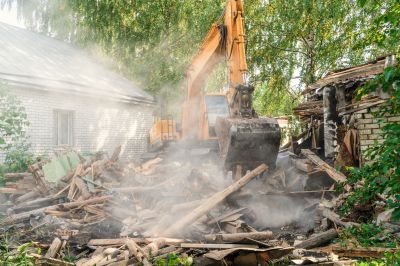Favorite Tools for Demolition Service Success
Identify trusted equipment that boosts efficiency and safety during complex demolition projects.
 Demolition work in Fresno, CA, requires a range of specialized tools and equipment to ensure efficient and safe operations. Whether tearing down structures, removing concrete, or clearing debris, selecting the appropriate products is essential for project success. From handheld tools to heavy machinery, the right equipment can streamline the process and reduce labor intensity. Understanding the variety of available products helps contractors and DIY enthusiasts alike make informed decisions tailored to their specific demolition needs.
Demolition work in Fresno, CA, requires a range of specialized tools and equipment to ensure efficient and safe operations. Whether tearing down structures, removing concrete, or clearing debris, selecting the appropriate products is essential for project success. From handheld tools to heavy machinery, the right equipment can streamline the process and reduce labor intensity. Understanding the variety of available products helps contractors and DIY enthusiasts alike make informed decisions tailored to their specific demolition needs.
Top Overall Option
Heavy-Duty Demolition Hammer
A versatile demolition hammer equipped with adjustable settings and ergonomic design can handle a variety of tasks such as breaking concrete, asphalt, and masonry. Its powerful motor and durable construction make it suitable for both professional contractors and serious DIYers. Features like vibration reduction and easy bit changes contribute to comfort and efficiency during extended use.
Types of Products For Demolition Service
Demolition Hammers
Electric or pneumatic hammers designed for breaking concrete, brick, and stone surfaces.
Jackhammers
Portable tools used to break up pavement, concrete, and other hard surfaces.
Reciprocating Saws
Power saws ideal for cutting through wood, metal, and drywall during demolition.
Crowbars and Pry Bars
Manual tools for prying apart structures and removing nails or fasteners.
Concrete Crushers
Heavy machinery attachments for crushing concrete debris into manageable sizes.
Demolition Saws
Cutting tools equipped with diamond blades for precise cuts in concrete and masonry.
Hydraulic Breakers
Powerful attachments for excavators used to break large concrete slabs and rocks.
Dust Extraction Systems
Equipment designed to control dust generated during demolition activities.
Safety Gear
Protective equipment including helmets, goggles, gloves, and respirators for worker safety.
Debris Containers
Durable bins and dumpsters for efficient debris collection and removal.
Scaffolding and Ladders
Support structures to access elevated areas safely during demolition.
Wrecking Balls
Heavy steel balls used with cranes for large-scale structural demolition.
Air Compressors
Power sources for pneumatic tools used in demolition tasks.
Vibratory Plate Compactors
Equipment for compacting soil or debris after demolition work.
Hand Sledgehammers
Manual tools for breaking smaller structures or removing nails.
Rotary Hammers
Heavy-duty drills for drilling into tough materials during demolition.
Wire Brushes and Scrapers
Tools for cleaning surfaces and removing old paint or coatings.
Portable Lighting
Illumination equipment for working safely in low-light conditions.
Popular Choices
Versatile and portable tools suitable for various demolition tasks.
Powerful tools favored for their ease of use and effectiveness.
Preferred for their durability and high power in heavy-duty demolition.
Popular for precise cuts in concrete and masonry structures.
Common manual tools for prying and removing materials.
Versatile attachments for small to medium demolition projects.
Widely used to maintain a clean and safe work environment.
Essential protective gear for all demolition activities.
Popular for directing debris safely from elevated work areas.
Commonly used with excavators for large-scale structural demolition.
Frequently used to illuminate work sites during low-light conditions.
Popular for efficient debris collection and disposal.
Standard equipment for reaching higher demolition areas.
Often used post-demolition to prepare the site for new construction.
Common manual tools for breaking smaller structures.
Frequently used to power pneumatic tools in demolition projects.
Popular for removing fasteners and cleaning surfaces.
Widely used to ensure visibility in dark or confined spaces.
In demolition projects, safety is paramount. Proper protective gear, reliable tools, and durable equipment contribute to safer work environments. Additionally, versatility in tools allows for handling different materials and structures, from wood and drywall to reinforced concrete and steel. Investing in quality products suited for demolition tasks can enhance productivity and minimize the risk of accidents or equipment failure.
Fresno's construction and renovation scene often involve projects that require efficient demolition solutions. Local contractors and homeowners should consider the scope and scale of their projects when choosing equipment. Whether it is a small interior tear-out or a large-scale building demolition, having the right tools ensures work progresses smoothly and meets safety standards. Proper planning and equipment selection are key to managing time, costs, and safety effectively.
Key Buying Considerations
- Assess the scope and scale of your demolition project to determine the appropriate equipment size and power.
- Prioritize safety features such as vibration reduction, ergonomic design, and protective gear compatibility.
- Consider the material types you will be working with, such as concrete, steel, or wood, to select suitable tools and attachments.
- Evaluate the power source options—corded, cordless, pneumatic, or hydraulic—based on site conditions and mobility needs.
- Check the durability and build quality of equipment to ensure reliable performance over multiple projects.
- Look for ease of use, including ergonomic handles, adjustable settings, and straightforward maintenance requirements.
- Review compatibility with existing tools and accessories to maximize versatility and investment value.
- Factor in noise levels, especially for indoor or noise-sensitive environments, and select quieter models if necessary.
- Consider the availability of replacement parts and customer support for long-term maintenance.
- Budget appropriately, balancing initial investment with expected lifespan and performance features.
- Ensure compliance with safety standards and regulations relevant to your location and project type.
- Evaluate the weight and portability of tools for ease of transport and maneuverability on-site.
- Look for additional features such as dust collection systems or vibration dampening to enhance safety and comfort.
- Research user reviews and expert opinions to gauge real-world performance and reliability.
- Plan for proper storage and handling to maintain equipment condition and safety.
